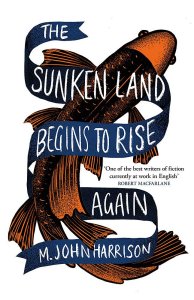Paul Di Filippo Reviews The Sunken Land Begins to Rise Again by M. John Harrison
 The Sunken Land Begins to Rise Again, M. John Harrison (Gollancz 978-0575096356, 272pp, hardcover) June 2020.
The Sunken Land Begins to Rise Again, M. John Harrison (Gollancz 978-0575096356, 272pp, hardcover) June 2020.
One does not merely read a novel by M. John Harrison; rather, one inhabits it. Or perhaps the uncanny novel inhabits the lucky reader. For the duration of the reader’s immersion in the text (or the immersion of the text in the reader), his or her consciousness is erased and supplanted with Harrison’s elaborate and perverse construction. Upon flipping the final page, the reader, newly unsure of her or his identity, finds reentry into consensus reality a difficult task. Which world exactly lies outside this room? Harrison’s subcreation, or the realm which the reader faintly remembers being born into?
And so it goes with Harrison’s newest, a disturbing tale of two hapless lives contoured by an enigmatic conspiracy.
Our first entry into this waking dream is a fellow named Shaw. In his late fifties, Shaw is emerging from a strange kind of nervous breakdown, and trying to reassemble the fragments of his life. (We will encounter revelatory bits and piece of his past, especially during his achingly combative visits to his Alzheimer’s-ridden mother, but the exact lineaments of Shaw’s history will remain nebulous.) As a move towards stability, Shaw rents a room in a shabby lodging house. His next-door neighbor, never seen, is a source of strange noises and odd comings and goings.
Shaw conducts a desultory yet somehow tender and important love affair with a woman named Victoria, whose own life is only slightly less discombobulated than Shaw’s. Their dialogue is a welter of lateral non-sequiturs and vatic pronouncements. One day Victoria announces she is relocating from London to Shropshire, to dwell in a new home. Her influence on Shaw seems over.
Shaw then encounters an odd fellow named Tim. Tim unaccountably takes a liking to Shaw and hires him as dogsbody for his peculiar business, based in a waterlogged houseboat, which seems to consist of delivering items no one wants or needs. Tim also runs a website named The Water House, which is a font of odd conspiracy theories relating to a cryptic species of beings hidden among humanity.
The narrative then leaves Shaw and follows Victoria. In her new town she meets a strange woman, a waitress named Pearl. Pearl claims to have known Victoria’s dead mother, and been intimate with her. But she refuses to divulge details. Victoria’s new home and town is host to queer individuals and strange doings not unconnected with Shaw’s mysteries. The garden attached to her home seems much bigger than it should be. Sourceless voices call out in the streets at night.
The third section circles around again to Shaw, and we witness the culmination of various activities in his life. Victoria comes back to London for a reunion, then departs again.
Part four tracks Victoria’s return to Shropshire and the climax of her life, before rejoining Shaw as his association with Tim implodes. But, miraculously, Shaw emerges from the debris new and improved. A delusional advancement? Perhaps, but perhaps not.
Now, this barebones schema barely begins to convey the rich and deep patterning of events and emotions that Harrison deploys. Every kind of water imagery (towpaths, rivers, pools, drains), certain talismans—a fish sculpture, the Victorian novel The Water Babies—rise and fall in a mysterious iconography, an ever-shifting mandala of coincidence and meaning that lingers at the edges of perception and understanding. From a reductionist standpoint, one could view this tale as a Lovecraftian encounter with Innsmouthian beings, a kind of M. R. James brush with other dimensions. But it is better apprehended as the journey of two souls—Shaw’s and Victoria’s—along intersecting arcs of confusion and transcendence. A quest for the true meaning of identity. “What’s the proper speed for living? What’s the appropriate density? What, even, constitutes a life?” These questions that Shaw mulls over are universal.
But the spiritual, metaphysical import of this book is woven into a brilliantly mimetic account of early-twenty-first century living, rife with anomie and ennui. Harrison’s eye for the details of fashion and consumerism is impeccable. He sketches types of people vividly, from the customers at a café to the workmen refitting Victoria’s house. Along with moments of eerie menace, we get droll dark humor. For instance, Shaw is assigned by Tim to attend one-on-one seances with a woman named Annie (who might or might not be Tim’s sister). After a regular diet of these odd sessions, Shaw tries to congratulate himself on having some new female companionship in his life—even though during most of their time together “Annie was unconscious.”
All these wonderful aspects of the book are delivered in prose that is far from showy, but nonetheless stuffed with rich metaphors.
Her spirits remained low. The weather wasn’t a help. Daytime temperatures fell. The sky filled from the south-west. Storms swept through each afternoon, their behaviour so strictly patterned they were like demonstration models: it grew quickly dark; lightning flickered; hail battered the old windows, settling thickly on the pavement outside the greengrocer’s, where braided streams of water instantly began melting through it like vast rivers observed by satellite. Twenty minutes later the pantomime had moved on, leaving a few sodden jackdaw feathers to collect as slick pulp on the orange tiles in a corner of the front area. Traffic hissed by, but seemed reduced. Inside, the rain had changed temporarily the acoustics, it had charged the air in the downstairs rooms so that her cushions and covers, though they remained dull and even a little grubby-looking, took on the pure painterly values and eerie depth of the objects on a Virago book cover in 1982.
Just masterful and deeply affecting, and so is the whole book.
Beginning his career in 1966, Harrison is approaching his fifty-fifth year of unrelenting inventiveness, the accumulation of which is about two dozen titles—one every couple of years. Not the most prodigious output, but rather a steady assault of talent upon the unrelenting mountain of reality.
Lushly cinematic yet deeply interior, The Sunken Land Begins to Rise Again is akin to some David Lynch film scripted by Christopher Priest; an Almodovar rendition of Brian Aldiss’s A Report on Probability A; or Terrence Malick’s version of any Ballard book. But these comparisons fail to capture the uniqueness of Harrison’s voice and the subtle virtuosity of his vision. Long may he continue as a sapper undermining the battlements of our mundane fortresses.
 While you are here, please take a moment to support Locus with a one-time or recurring donation. We rely on reader donations to keep the magazine and site going, and would like to keep the site paywall free, but WE NEED YOUR FINANCIAL SUPPORT to continue quality coverage of the science fiction and fantasy field.
While you are here, please take a moment to support Locus with a one-time or recurring donation. We rely on reader donations to keep the magazine and site going, and would like to keep the site paywall free, but WE NEED YOUR FINANCIAL SUPPORT to continue quality coverage of the science fiction and fantasy field.








The book is called “The Sunken Land Begins to Rise Again,” not, as the reviewer here exclusively refers to it, “The Sunken Land Begins to Rise.”
Thanks, we’ve corrected it!
Otherwise the review is dead on – generous, well-written and to the point. I just finished reading the book and immediately wanted to encourage other people to start. A lot of people are reading it The horror elements are mostly satire, and funny with it – The Shadow Over Bridgnorth – but then some of the reflections of Brexit Britain are genuinely creepy. And, even working in this small pond, Harrison still manages to pull off his trademark trick of handing you the secret to life but then somehow leaving you staring into an ornate but empty box – even though you knew from the start he was going to do exactly that. It remains an exceptional pleasure watching him work.
The horror elements are mostly satire, and funny with it – The Shadow Over Bridgnorth – but then some of the reflections of Brexit Britain are genuinely creepy. And, even working in this small pond, Harrison still manages to pull off his trademark trick of handing you the secret to life but then somehow leaving you staring into an ornate but empty box – even though you knew from the start he was going to do exactly that. It remains an exceptional pleasure watching him work.